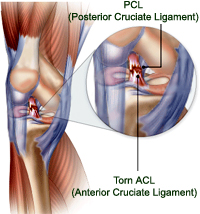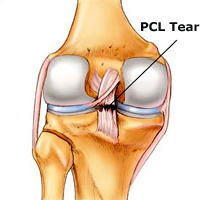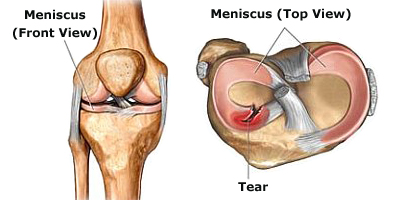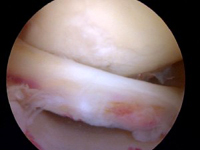Knee Replacement
Arthroscopic knee surgery is a treatment option for certain knee pain types where a small camera is inserted inside joint and through other small incisions instruments are inserted for repairing damaged structures. Also called ‘scoping the knee’ or knee arthroscopy, Dr. L. Tomar says some of the reasons that require performance of an arthroscopic knee surgery include:
Meniscus Surgery/Torn Cartilage – This involves removal of portion of meniscus cartilage (Shock-absorbing wedge of cartilage sitting between bone ends to provide cushioning & support for knee joint). Here, smaller meniscus tears are usually trimmed for relieving symptoms of torn meniscus.
Meniscus Repair – It is a surgical procedure that is undertaken for repairing damaged meniscus. Meniscus repair helps in restoring normal anatomy of knee and has long term affects. But as meniscus repair is a significant surgery, the recovery time is longer. Further, the limited blood supply to meniscus also does not make meniscus repair possible.
ACL Reconstruction – Anterior cruciate ligament (ACL) is one of four major knee ligaments and plays critical part in ensuring knee stability. With patients getting injury of ACL often complaining of knee giving out from under them, the majority of the people sustaining ACL tear opt for surgical treatment that is mainly performed through arthroscopic means.
Plica Excision – Plica (a remnant of tissue leftover from fetal development) are dividers of knee in early knee development phase. With dividers gradually lost over time, still for some remnant remains. When these remnant tissues are more prominent, it is called plica. The irritation caused by the plica is called plica syndrome. For providing relief, plica resection is performed to remove the irritating tissue.
Lateral Release – Kneecap movement is up and down the end of thigh bone in groove of cartilage. Due to injuries, the kneecap can be pulled to outside of this groove or even may dislocate from groove, thus causing pain while the knee is in the bending position. For providing relief through surgical process, a lateral release is performed. This helps in loosening ligaments that pull kneecap toward outside of the groove.
Micro fracture – It comprises of treatment that is used for stimulating body to grow new cartilage in area of damaged cartilage. In micro fracture procedure, firm outer layer of bone is penetrated that leads to exposure of inner layers of bone (where marrow cells exist). These cells can then access damaged area as well as used to fill in gap of cartilage.
Autologous Chondrocyte Implantation – Autologous Chondrocyte Implantation involves transfer of cartilage from healthy parts of joint to damaged areas. For this, small plugs of cartilage are surgically removed with portion of underlying bone and then transferred to area of damage.
Anterior cruciate ligament (ACL)
Anterior cruciate ligament (ACL) is one of four major knee ligaments that are critical to knee stability that prevents excessive motion of knee joint. As per Dr. L. Tomar people injuring their ACL complain of symptoms of knee giving-out. Many patients sustaining ACL tear prefer to have surgical treatment of this injury.
ACL tear is often related to sports injury and can also occur during mishaps like:
- Driving vehicle collision
- Falls
- Work-related injuries
Most often ACL tears occurs when pivoting/landing from jump where the tear occurs and knee gives-out from under athlete.
Signs of ACL Tear
Diagnosis of ACL tear is made using several methods. These include:
- Previous sustained injury to knee (Often sports-related)
- Knee swelling and pain
- Other signs of instability of knee
Other than these, an MRI can also be used for determining:
- If ligament is torn
- To look out for signs of other associated injuries in knee

Posterior cruciate ligament (PCL)
Posterior cruciate ligament (PCL) is one of four important ligaments that help in providing stability of knee joint. This ligament helps in preventing tibia (shin bone) from sliding too far backwards.
Injury Causes of PCL
The most common of the causes of injury of PCL is called ‘dashboard injury’ that occurs when knee is in bent position and an object forcefully strikes shin backwards. Commonly seen in car collisions when shin forcefully strikes dashboard, some of the other reason that allows occurrence of this injury is when athlete falls on front of their knee. In this case knee is bent all the way back with foot held pointing downwards. These types of situations put stress on PCL with a resultant tear.

Symptoms of PCL
Some of the common symptoms of PCL tear are:
- Knee pain
- Swelling
- Decreased motion
If complaint of instability comes from the patients (a problem after PCL injury) then it may be indicator of surgery that needs to be performed to correct the issue.
Meniscus Surgery
The menisci are made of tough cartilage and conform to surfaces of bones upon which they rest. There are two menisci in the knee with each resting between thigh bone (femur) and shin bone (tibia). The meniscus present in the inside of knee is called medial meniscus and other meniscus resting on outside of knee is called lateral meniscus.
Meniscus helps in distributing body weight across knee joint and without its presence the weight of is unevenly applied to bones in legs (femur and tibia). Being C-shaped, its wedged profile helps in maintaining stability of joints by keeping rounded femur surface from sliding off flat tibial surface. The distribution of uneven weight causes excessive force in specific body areas that in turn leads to early arthritis of knee joint.

Working of Meniscus
Knee joints are important to allow people to perform daily activities. The joint is made up of three bones:
- Femur (thigh bone)
- Tibia (shin bone)
- Patella (knee cap)
As surfaces of these bones within joint are covered with layer of cartilage, it allows bones to smoothly glide without causing damage to them. Meniscus sits between cartilage surfaces of bones and helps in distributing weight as well as in improving stability of joints.
Meniscus Tear
The common reason for traumatic meniscus tear is when knee joint is bent and knee is twisted. Most common causes of meniscus tear are:
- Traumatic injury (that experienced by athletes)
- Degenerative processes (seen in older patients)

